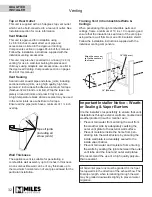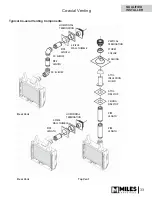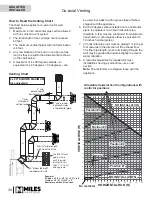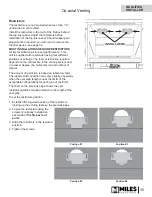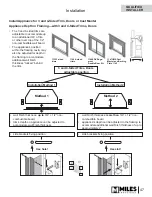
32
10” (254 mm)
10” (254 mm)
Align the vent cen-
ter to the center of
the frame
Venting
Top or Rear Outlet
This unit is supplied with a 45 degrees top vent outlet
which can be fi eld-converted to a rear vent outlet. See
Installation
section for more information.
Vent Material
This unit is approved for installation using
4 x 6-5/8 inches co-axial direct vent pipe and
accessories as listed in the
Approved Venting
Components
section on pages 65–66 of this manual.
Follow the installation instructions supplied with the
individual venting accessories.
This unit may also be converted to co-linear (3 x 4 in)
venting for use in solid-fuel burning fi replaces and
chimneys using adapters and accessories—see list in
the
Approved Venting Components
section on pages
65–66 of this manual.
Vent Sealing
Seal all outer coaxial pipe and elbow joints, including
sectioned elbow joints, using high quality, high tem-
perature 2 inch wide self-adhesive aluminum foil tape
(Nashua-322-2 brand or similar). Wrap the tape com-
pletely around all joints and press fi rmly to seal.
A high temperature black silicone sealant may be used
in the outer joints as a substitute to foil tape.
Ensure all the pipe joints have a minimum of 1 ¼ inch
overlap.
Wall Thickness
The appliance vent is suitable for penetrating a
combustible wall assembly up to 8 inches in thickness.
A non-combustible wall can be of any thickness up to
the maximum horizontal run of vent pipe allowed for the
particular installation.
Framing Vent in Combustible Walls &
Ceilings
When penetrating through combustible walls and
ceilings, frame a minimum of 10 in x 10 in opening and
ensure that the insulation is kept clear of the vent pipe
using either a wall thimble or an attic insulation shield.
Follow the installation instructions supplied with the
individual venting components.
Important Installer Notice – Weath-
er Sealing & Vapor Barriers
It is the installer’s responsibility to ensure that vent
installations through exterior walls are caulked and
weatherproofed in such a manner as to:
• Prevent rain water from entering the wall from
the weather side by adequately caulking the
outer vent plate to the exterior wall surface.
• Prevent moisture inside the home from pen-
etrating into the wall structure by ensuring the
inside wall plate is adequately sealed to the
inside vapor barrier.
• Prevent rain water and moisture from entering
the walls by sealing the joints between the outer
vent tube and the inner and outer wall plates.
We recommend the use of a high quality polyure-
thane sealant.
Tape all joints
(including all
elbow joints)
All horizontal pipe runs must be graded 1/4 inch per
foot upwards in the direction of the exhaust fl ow. The
fi nal pipe length, when terminating through the wall
may be graded downwards slightly to prevent water
migration.
QUALIFIED
INSTALLER















